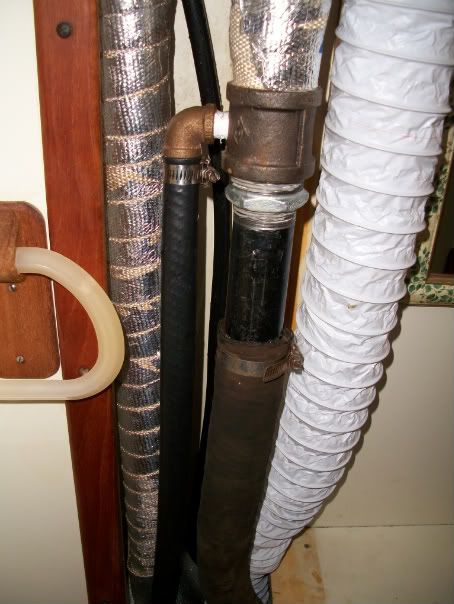I have a Tartan 30 with an Atomic 4 which is new to me this year and I have been learning about the workings of the A4. This forum certainly has been helpful. One of the issues that I have had is water intrusion into the engine.
After a cruise this summer I found water in the oil (milky) but none in the cylinders. I have done the oil changes and I am now going through the diagnostics to try and find the cause. So far I have tested the compression – seems fine 1 and 2 are 90 and 3 and 4 are 100, pressure tested the manifold and pressure tested the block. All seem ok. The engine starts easily and runs well.
I am a bit suspicious of my exhaust system and would appreciate any comments. The engine in the T30 is mounted mid-ships and the exhaust goes out at the forward (flywheel) end. The cooling water goes through the manifold, out the aft end, through a loop up into a bulkhead ahead of the engine – there is a siphon break at the top of the loop - and back down into the hot section of the exhaust. It mixes with the exhaust into a water lift muffler, which goes up the bulkhead through a loop and the out the port side. I don’t believe this is the original exhaust in the boat.
One part of the exhaust system I question is where the cooling water enters the hot section of the exhaust. It is not very far below the lower part of the exhaust port – only 1 or 2 inches (see picture 1) and seems like it could get into the manifold. I believe the recommendation is at least 4 inches. The other question I have is the height of the cooling water loop and the loop after the water lift muffler. These are both well above the waterline, approximately 40 inches. Would either of these areas of the exhaust system cause water to back up into the manifold?
This past weekend I took the hot part of the exhaust apart and could see a bit of water near the forward end of the manifold. I have extended the hot exhaust pipe lower and moved the water mixing pipe lower (see picture 2).
Any comments on the exhaust and/or other areas to check for water intrusion would be much appreciated.
Thanks,
Geoff
After a cruise this summer I found water in the oil (milky) but none in the cylinders. I have done the oil changes and I am now going through the diagnostics to try and find the cause. So far I have tested the compression – seems fine 1 and 2 are 90 and 3 and 4 are 100, pressure tested the manifold and pressure tested the block. All seem ok. The engine starts easily and runs well.
I am a bit suspicious of my exhaust system and would appreciate any comments. The engine in the T30 is mounted mid-ships and the exhaust goes out at the forward (flywheel) end. The cooling water goes through the manifold, out the aft end, through a loop up into a bulkhead ahead of the engine – there is a siphon break at the top of the loop - and back down into the hot section of the exhaust. It mixes with the exhaust into a water lift muffler, which goes up the bulkhead through a loop and the out the port side. I don’t believe this is the original exhaust in the boat.
One part of the exhaust system I question is where the cooling water enters the hot section of the exhaust. It is not very far below the lower part of the exhaust port – only 1 or 2 inches (see picture 1) and seems like it could get into the manifold. I believe the recommendation is at least 4 inches. The other question I have is the height of the cooling water loop and the loop after the water lift muffler. These are both well above the waterline, approximately 40 inches. Would either of these areas of the exhaust system cause water to back up into the manifold?
This past weekend I took the hot part of the exhaust apart and could see a bit of water near the forward end of the manifold. I have extended the hot exhaust pipe lower and moved the water mixing pipe lower (see picture 2).
Any comments on the exhaust and/or other areas to check for water intrusion would be much appreciated.
Thanks,
Geoff


Comment